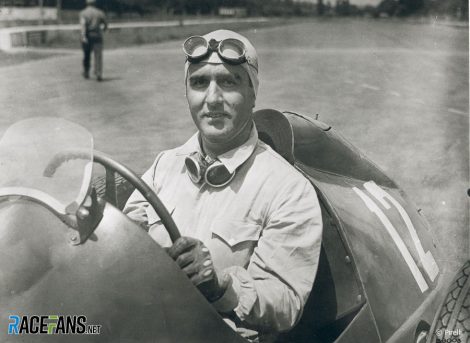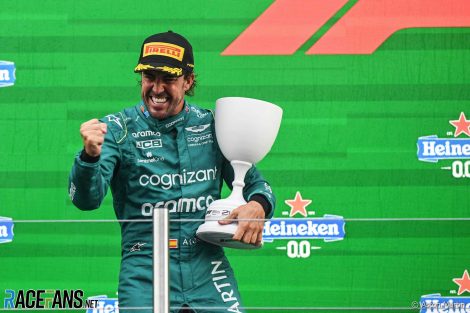Fernando Alonso’s new contract will see him become the oldest driver to take part in a Formula 1 race for more than five decades.
His new deal will keep him at Aston Martin at least until the end of the 2026 season. Assuming he sees out that deal and the season doesn’t end abnormally early, Alonso will be racing past his 45th birthday in July 2026.
That will make him the oldest driver on the grid since another two-times world champion, Graham Hill, ended his career in 1975. Hill was 45 years and 345 days old when he started that year’s race at Interlagos.
He made two further attempts to qualify that year but didn’t make it onto the grid on either occasion. By the last race which Hill failed to qualify for, the Monaco Grand Prix, he had celebrated another birthday and was now 46 years and 85 days old. Since then, few drivers have raced on into their fifth decade.
Hill is an appropriate driver for Alonso to find symmetry with. Both are two-times world champions and both tackled the ‘triple crown’ of races with great success. Hill is the only driver to win the Monaco Grand Prix, Le Mans 24 Hours and Indianapolis 500, while Alonso has triumphed in the first two and tackled the latter three times.
*Verstappen, Hamilton and Alonso: Age at 2024 Japanese Grand Prix
Advert | Become a RaceFans supporter and
It wasn’t unusual for drivers to race into their forties and even fifties during the first decade of the world championship. But the dangers of the time also took a toll.
The first two world champions, Giuseppe Farina and Juan Manuel Fangio, were well into their forties when they retired. But Alberto Ascari died during his career and Mike Hawthorn was just months into his retirement when he died in a road crash.
The fates of Jim Clark and Jochen Rindt – the only driver to win the championship posthumously – made some question why multiple champions Jack Brabham and Graham Hill kept racing so late in their careers. The former enjoyed a long retirement while the latter died in a plane crash soon after retiring.
But as the physical demands of driving cars grew in the late seventies, and new drivers started their careers earlier, those with the luxury of choosing when to end their careers increasingly did so in their thirties. Since Hill’s retirement only 10 drivers started grands prix after their 40th birthday:
| Driver | Age at last start | Last race |
|---|---|---|
| Vittorio Brambilla | 42 years, 308 days | 1980 United States Grand Prix |
| Mario Andretti | 42 years, 209 days | 1982 Las Vegas Grand Prix |
| Jacques Laffite | 42 years, 234 days | 1986 British Grand Prix |
| Rene Arnoux | 41 years, 124 days | 1989 Australian Grand Prix |
| Philippe Alliot | 41 years, 32 days | 1994 Belgian Grand Prix |
| Nigel Mansell | 41 years, 279 days | 1995 Spanish Grand Prix |
| Pedro de la Rosa | 41 years, 275 days | 2012 Brazilian Grand Prix |
| Michael Schumacher | 43 years, 327 days | 2012 Brazilian Grand Prix |
| Kimi Raikkonen | 42 years, 56 days | 2021 Abu Dhabi Grand Prix |
| Fernando Alonso | 42 years, 253 days | 2024 Japanese Grand Prix |
Advert | Become a RaceFans supporter and
Are we about to see a reversal of that trend? Despite the unceasing demands of Formula 1’s longest-ever calendars – 24 rounds again next year – there are strong factors pushing drivers towards longer careers.

Today’s cars are not necessarily less physically demanding to drive, but in this era of high tyre degradation drivers like Alonso do not need to consistently push them to the limit over a race distance as they did in the days of the tyre war.
As F1 has become so specialised, and the cars raced in single-spec junior categories so far removed from it, teams are increasingly reluctant to take a chance on youth. For the first time ever, the field at the opening race of this season was unchanged from the one which contested the previous year’s concluding race.
The value of experience to teams has therefore risen in recent years as rookies have less time to find their feet. First F1 slashed testing to almost nothing, lately it has cut back Friday practice sessions from 90 minutes to 60 and introduced sprint events where only a single practice session takes place. Ironically, few drivers have complained about this as vociferously as Alonso.

Championship-winning drivers are inevitably valued higher, so the pull for them to continue is stronger. That doesn’t mean they can’t resist it: Nico Rosberg couldn’t face another season like his 2016 championship-winning campaign and quit despite having signed a two-year contract extension just five months earlier. Sebastian Vettel simply realised there is more to life.
But others press on. Kimi Raikkonen was content to spend his last seasons racing the midfield. Hamilton has surprised himself by committing to race into his forties, taking up a once-in-a-career chance to join Ferrari, hoping to regain his lost, record-breaking eighth title.
As for Alonso, he clearly still has the love for racing. But he is also driven by a desire to claim his long-sought third world title, even if it takes him two decades or more.
Advert | Become a RaceFans supporter and
Become a RaceFans Supporter
RaceFans is run thanks in part to the generous support of its readers. By contributing £1 per month or £12 per year (or the same in whichever currency you use) you can help cover the costs of creating, hosting and developing RaceFans today and in the future.
Become a RaceFans Supporter today and browse the site ad-free. Sign up or find out more via the links below:
Formula 1
Browse all Formula 1 articles














